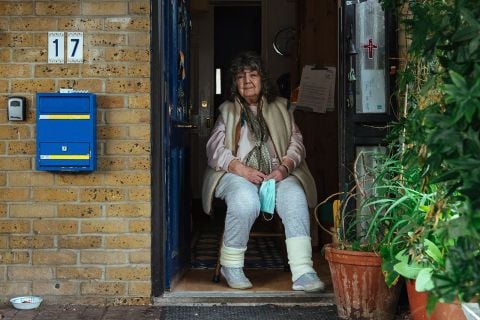Indoors: an online photography exhibition of older people in lockdown
Indoors, an online photography exhibition backed by research from the University of Oxford, is launched today [Nov 12], bringing to life through striking portraits and interviews how older residents of east London struggled with, and adapted to, lockdown life.
Their stories are interwoven with insights from research in social science, ethics and history into the impacts of isolation. These poignant, powerful images offer vital lessons in the role of meaningful interaction and resilient communities in a time of crisis.

Even before the COVID-19 pandemic, older members of society were significantly more vulnerable to loneliness and isolation. But the lockdowns have brought new and unprecedented challenges, with the closure of social activities, the need for shielding and restrictions on family visits.
This exhibition is the result of a collaboration between London-based photographer Adam Isfendiyar and a multi-disciplinary group of Oxford researchers.
When the spring 2020 lockdown curtailed his normal work, Adam wondered about documenting the personal stories of local residents by taking their portraits at their windows and front doors. Within two days of posting a call for participants on the Tower Hamlets Mutual Aid WhatsApp group, Adam received more than 80 replies. In his ‘exercise hour’, he cycled from house to house to take the socially-distanced portraits, which he posted on his blog as ‘Life under Lockdown’.
For the VE day anniversary, he focused on the lockdown experiences of those who had lived through the Second World War.

Dr Federica Lucivero, from Oxford’s Ethox Centre, for population health, came across the VE Day photographs. She says, ‘We frequently heard people comparing the pandemic to WW2 and at the same time discussing the vulnerability of older people in the pandemic, but what struck me is that people portrayed by Adam had a first-hand experience of both.’
Professor Michael Dunn, who researches the social and ethical dimensions of long-term care for vulnerable communities, maintains,‘The photographs provoked us to think about how our research in ethics, social science and history took shape in, and connected to, real-world experiences in new and important ways.’
He adds, ‘I hope people will leave the exhibition with a new sense of how they might understand their responsibilities to older members of our society, how they might support them, how they might shape their opportunities, and how they might build and strengthen communities in ways that involve them.’
Dr Roderick Bailey, who specialises in the study of the Second World War and the histories of health and infectious disease says, ‘The reflections of older people who went through the Second World War also encourage us to think critically about comparing our experience of this pandemic to previous times of national crisis. Is it right and helpful to think of a pandemic as a time of war and a pathogen as an enemy? The memories of those who experienced the Second World War have much to tell us about the perspectives of different generations and ideas of vulnerability.’
Meanwhile, researcher Mira Schneiders, says ‘The images and stories also challenge the stereotype of older people being frail and a burden on society. Instead, they show older people being resourceful and finding creative ways to cope and stay connected in difficult times.’
Adam Isfendiyar concludes, ‘Everyone is affected by this pandemic in different ways. Doing something as small as making a phone call or offering to help with shopping, can make a world of difference to certain members of our community who are prisoners to this pandemic.’

The online launch event for the exhibition will take place today [Nov 12] at 16:00 – 16:45, access is via the following link: http://ow.ly/ojde50BXhK. Following the launch event, the exhibition will be freely available to view here. The exhibition is part of the nationwide Being Human Festival.
We would like to thank all of the participants included in the photographs and also Wellcome for funding this public engagement project.

